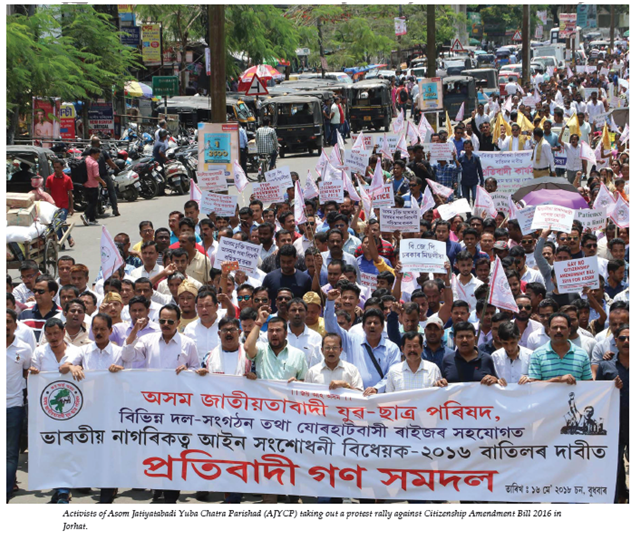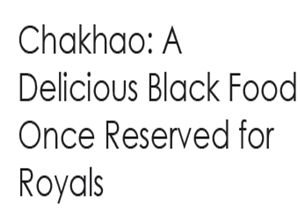- Parent Category: 2018
Letter from the Editor
The Tug Of War for the Citizenship Amendment Bill in the Northeast of India and more so in Assam is an issue which will decide the faith of the entire Northeast of India and more so the country in the times to come. We have tried to give brief details about the bill and take the views from both the parties who are for and against the bill.
The Bill introduced in the Lok Sabha on July 15, 2016 amends the Citizenship Act, 1955 to make illegal migrants who are Hindus, Sikhs, Buddhists, Jains, Parsis and Christians from Afghanistan, Bangladesh and Pakistan, eligible for citizenship. What is interesting is the Christian dominated state of Meghalaya has also out rightly rejected the bill. One can understand it is not about religion but about saving ones way of life. In Assam the only state today where NRC is being updated in the country, what does this bill mean? The division of the state into two fragments who are supporting and against the bill can be seen by just how the demography has changed in those regions since the settlement of the refugees of the Bangla Liberation War. Representatives from approximately 159 organisations and political parties, including Asom Gana Parishad (AGP) – (the coalition partner of BJP in the state of Assam), met the 16-member JPC team headed by Rajendra Agarwala which was recently there in the state of Assam to know the ground realities. The Bill contradicts the Assam Accord of 1985, which clearly demarcates the cut-off time of illegal immigrants from the state on March 25, 1971.
Interestingly India is not a signatory of the United Nation Refugee Convention; therefore it is not required to provide safe haven to people seeking asylum from persecution in other countries. However, the specific use of particular religions and excluding the other religious minorities who are also being persecuted in the neighboring countries is missing in the Bill. One can only wonder, if the outright motive was humanitarian then why instead of mention the religions in the Bill, the simple two words of ‘religious minorities’ was not included? Also if the idea is to support prosecuted religious minorities then why ask the states of Northeastern India to shelter even one and I repeat even one refugee when all our economic indices are in negative and we need funds to support our sustenance from the center? Why don’t the bigger economic powerhouse States of our great nation come forward and say ‘Yes, don’t worry we will settle all the incoming refugees with us and no one will be allowed to settle in the Northeastern region”?
This battle of the Citizen’s Amendment Bill is not about being a good human or not. IT is all about the survival of a distinct, beautiful way of life that is not known in most parts of the world. The northeastern part of the country cannot bear the brunt of refugee’s influx in the states. If this happens, history might repeat itself, as the unemployed youths may become even more delusional then before and all the unwanted events of the past, as well as the weaken separatist movements existing, may get the shot in the arm that they need for their survival.
The issue of Citizenship Amendment Bill is not only sensitive but also very complicated in nature. As the ruling Bharatiya Janata Party has re-iterated that all the Hindus who migrated from Bangladesh will be granted Indian Citizenship, but the indigenous Assamese communities and people of northeast India are simply not willing to accept this as the probability of them becoming minority in their own states is significantly high. There is also the feeling of threat to their Indigenous Language and Culture. In such circumstances, political maturity is required to settle the issue. We have to wait and watch.
Harsh Jhunjhunwalla
Add a comment


 the media reporting and related contents, it’s convincing that the Brahmaputra valley of the Northeastern State has been witnessing an uproarious situation for a few weeks now. Few observers may compare the situation to the days of Assam agitation, which culminated in 1985 with an accord signed by the agitators and the Union government in New Delhi. Millions of participants in six years long agitation wanted to deport all illegal migrants from Assam, but the leaders agreed in the accord to accept all the migrants till 25 March 1971 in the State. The agitation witnessed the sacrifices of over 850 martyrs and thousands of others in different shape and sizes, who all wanted to deport the illegal migrants with the national cut off year (1951). But the accord agreed to identify only those people, who entered Assam after 24 March 1971, as illegal foreigners. Need to be mentioned that the accord was never placed in the Parliament for endorsement. After more than three decades of the signing of the accord, the people of Assam (more precisely the civil society group representatives and media stalwarts in Brahmaputra valley) are fantasizing of another uprising. This time it is against the Centre’s initiative to grant citizenship to those religious asylum seekers from Bangladesh, Pakistan and Afghanistan.
the media reporting and related contents, it’s convincing that the Brahmaputra valley of the Northeastern State has been witnessing an uproarious situation for a few weeks now. Few observers may compare the situation to the days of Assam agitation, which culminated in 1985 with an accord signed by the agitators and the Union government in New Delhi. Millions of participants in six years long agitation wanted to deport all illegal migrants from Assam, but the leaders agreed in the accord to accept all the migrants till 25 March 1971 in the State. The agitation witnessed the sacrifices of over 850 martyrs and thousands of others in different shape and sizes, who all wanted to deport the illegal migrants with the national cut off year (1951). But the accord agreed to identify only those people, who entered Assam after 24 March 1971, as illegal foreigners. Need to be mentioned that the accord was never placed in the Parliament for endorsement. After more than three decades of the signing of the accord, the people of Assam (more precisely the civil society group representatives and media stalwarts in Brahmaputra valley) are fantasizing of another uprising. This time it is against the Centre’s initiative to grant citizenship to those religious asylum seekers from Bangladesh, Pakistan and Afghanistan.

 The GI is a mark/sign/symbol used on a particular product to indicate its geographical origin and inherent natural qualities that differs it from other similar product. It can bring about a major revolution on the agrarian scenario of Manipur. Chakhao is poised to become one of the commodities in the export basket of this state.
The GI is a mark/sign/symbol used on a particular product to indicate its geographical origin and inherent natural qualities that differs it from other similar product. It can bring about a major revolution on the agrarian scenario of Manipur. Chakhao is poised to become one of the commodities in the export basket of this state.